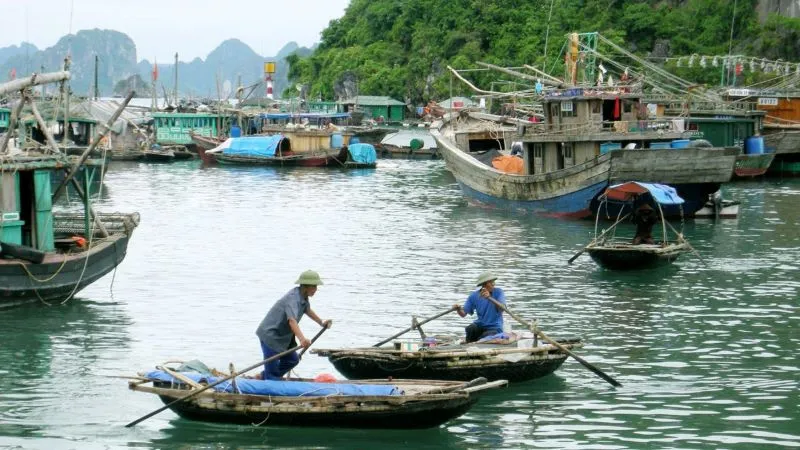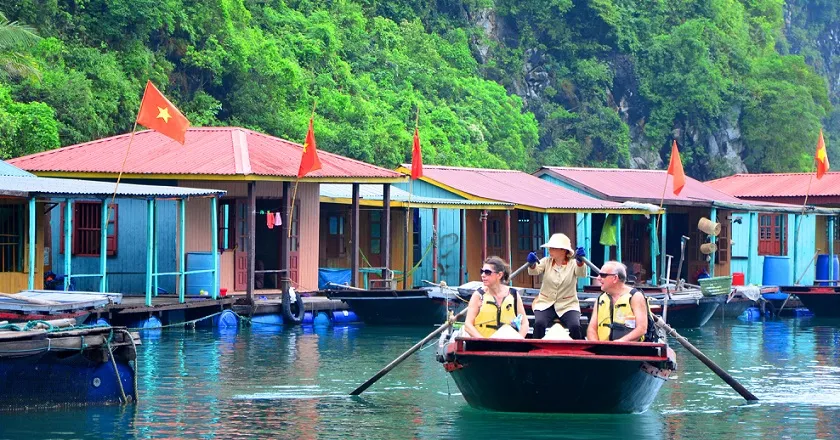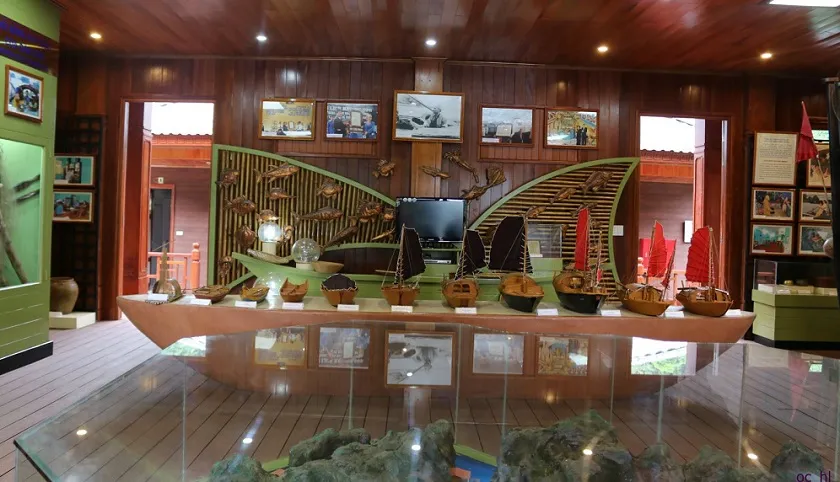Imagine gliding gently on the emerald waters of Ha Long Bay, surrounded by magnificent, towering limestone karsts. Suddenly, a floating village emerges—small, colorful houses clustered together, creating a tranquil and captivating scene. This is the ancient Cua Van fishing village, a unique destination for anyone who loves experiential travel and cultural exploration. It enchants visitors not only with its unspoiled natural beauty but also with its slow-paced, serene lifestyle and the traditional cultural values cherished for generations.
Cua Van Floating Village: A Timeless Mark on Ha Long Bay
Cua Van floating village, a hidden gem in Ha Long Bay, is located in Hung Thang commune, Ha Long city, Quang Ninh province. The village has a long history, originating from the ancient fishing villages of Giang Vong and Truc Vong. Through the ups and downs of time, Cua Van is not only an inseparable part of the World Natural Heritage Site of Ha Long Bay but also a historical witness, preserving the unique traditional cultural values of Vietnam’s Northeast coastal region.

Aerial view of Cua Van floating village
In the past, Cua Van was home to over 300 households, whose lives were closely tied to fishing. The stilt houses clustered closely together, bobbing on the water, created a unique living space unlike any other. In 2012, to preserve and promote the cultural values of the fishing village, and to improve the quality of life for residents, the local authorities relocated the villagers to the mainland. Today, Cua Van is no longer the daily residence of locals, but has become an attractive cultural tourism destination, captivating visitors with its ancient beauty and unique cultural experiences. However, the village still retains about 12 rafts, including a classroom, a cultural house, and a few fishing households who continue to live by the sea, creating a vibrant and authentic living space.
Cua Van’s beauty is recognized not only domestically but also internationally. The village was once voted among the top 16 most beautiful ancient villages in the world by a reputable travel website, demonstrating its special appeal to international tourists. Visiting Cua Van, tourists not only admire the stunning natural scenery but also have the opportunity to learn about the history, culture, and life of the coastal fishing community.
Immerse Yourself in Village Life: Unforgettable Experiences
A travel experience to the ancient Cua Van fishing village will take you to a completely different world, where time seems to slow down, and life is simple and close to nature. As soon as you arrive in the village, you will feel the peace and tranquility that permeates the space, a stark contrast to the hustle and bustle of the city. The beautiful natural scenery, with clear blue water, majestic limestone mountains, and gently moored wooden boats, will make you feel relaxed and at ease.

Tourists kayaking at Cua Van fishing village
One of the must-try experiences when visiting Cua Van is participating in activities to explore the life of fishermen. You can try your hand at rowing a bamboo boat, weaving through the narrow alleys between the rafts, and observing the daily life of the locals. If you want to experience the feeling of becoming a real fisherman, you can participate in activities such as net fishing, angling, or even night squid fishing with the villagers. These activities not only provide you with exciting moments but also help you better understand the hardships, yet also the optimism and love of life of the children of the sea.
During traditional festivals, Cua Van becomes more vibrant and bustling than ever. You will have the opportunity to enjoy sweet cheo duong and hat gheo melodies, immersing yourself in the rich national cultural space. These sounds, dances, and songs are not only forms of entertainment but also a way for the villagers to express their love for their homeland, country, and ancestral cultural traditions.
To gain a deeper understanding of the history and culture of the fishing village, don’t forget to visit the Cua Van Floating Culture Center. This place is considered a living museum, preserving over 1200 valuable documents, images, and artifacts about the material and spiritual life and traditional cultural activities of the people of Cua Van. The artifacts are displayed in 5 main themes: fishermen’s livelihoods, the material life of fishermen, water dwellings and human life, spirituality and spiritual life, for today and for generations to come. Visiting the cultural center, you will have a comprehensive and deeper understanding of the formation and development of Cua Van fishing village, as well as the unique cultural values that this village has preserved and promoted.

Inside the Cua Van Floating Cultural Center
Experiential tourism in the ancient Cua Van fishing village is not only a journey to discover natural beauty but also an opportunity for you to immerse yourself in community life, learn about traditional cultural values, and enjoy peaceful, relaxing moments in the heart of a world natural heritage site.
Journey to Cua Van: Detailed Guide From A to Z
To reach Cua Van fishing village, you can depart from Tuan Chau tourist wharf, about 20km from the village. There are several transportation options for you to consider:
- Tourist boat: This is the most popular means of transportation to Cua Van. You can buy boat tickets at Tuan Chau wharf or book in advance through travel companies. Ha Long Bay cruise tours often include a visit to Cua Van fishing village, which is a convenient option if you want to explore many other destinations on the bay.
- Canoe: If you want to travel quickly and be proactive about time, a canoe is a suitable option. However, the cost of renting a canoe will be higher than taking a tourist boat.
- Private boat: For large groups or those who want privacy, renting a private boat is a good idea. You can contact travel companies or locals to rent a boat.
Cua Van fishing village belongs to Ha Long Bay sightseeing route No. 3, including destinations: Cua Van Fishing Village, Tien Ong Cave, Ba Ham Lake. When booking a tour or transportation, you should note this information to ensure your itinerary is as desired.

Foreign tourists experiencing bamboo boat rowing in Cua Van
Travel time from Tuan Chau wharf to Cua Van takes about 30-45 minutes depending on the type of vehicle and speed. Throughout the journey, you will admire the majestic beauty of Ha Long Bay, with thousands of limestone islands bobbing on the water, creating an incredibly impressive natural picture.
Travel Tips for Cua Van Fishing Village: For a Perfect Trip
To have a truly memorable and complete travel experience in the ancient Cua Van fishing village, keep these useful tips in mind:
- Ideal time to visit: The best time to visit Cua Van is from April to June. At this time, Ha Long weather is quite pleasant, sunny but not too harsh, very suitable for sightseeing and exploring the islands.
- Clothing: You should choose comfortable, cool, and sweat-absorbent clothing. Don’t forget to bring a hat, sunglasses, and sunscreen to protect your skin from the sun. If you intend to participate in water activities, prepare swimwear and towels.
- Personal items: Cameras and phones are indispensable items for you to capture memorable moments in Cua Van. Remember to bring a power bank so you don’t miss any beautiful moments. In addition, you should also bring some basic medicines such as motion sickness medicine, stomachache medicine, cold medicine…
- Book services in advance: During peak tourist season, you should book boat tickets, canoes, cruise tours, and other services in advance to ensure your trip is smooth and convenient.
- Respect local culture: When visiting the fishing village, respect the customs, traditions, and lifestyles of the locals. Maintain general hygiene, do not litter indiscriminately, and limit loud noises so as not to affect the peace of the fishing village.
- Enjoy local cuisine: Don’t miss the opportunity to enjoy fresh seafood and local specialties in Cua Van. You can enjoy a meal on the rafts or floating restaurants on the bay to both enjoy the cuisine and admire the beautiful scenery.
Village Cuisine: Rich Sea Flavors with Distinctive Identity
Cua Van fishing village cuisine is an indispensable part of the travel experience here. With abundant fresh seafood caught directly from the sea, the dishes in Cua Van have a distinctive flavor of Ha Long Bay.
Fresh seafood such as shrimp, crab, squid, fish… are prepared in many different ways, from steaming, grilling, stir-frying to hot pot, salad, bringing visitors diverse and attractive culinary experiences. You can enjoy fragrant steamed squid with ginger, spicy grilled shrimp with salt and chili, sweet and sour tamarind crab, or hot seafood hot pot, rich in sea flavor.
In addition to seafood, Cua Van also has other local specialties such as horseshoe crab, ngan (clam-like shellfish), and geoduck. These are all unique dishes, imbued with the culinary culture of Quang Ninh coastal region. You can find these dishes at restaurants and floating eateries on the bay or enjoy them directly on the rafts of local people.
Enjoying village cuisine is not only about filling your hungry stomach but also an opportunity for you to explore and experience more deeply the culture and life of the coastal people. Each dish contains stories, cultural values, and cooking secrets passed down through generations.
Cua Van fishing village, with its peaceful beauty and unique cultural experiences, will surely be an ideal destination for those who want to seek difference and discover traditional values in the heart of majestic nature. Come and feel it, so that memories of Cua Van will forever linger in your journey of exploring the world.